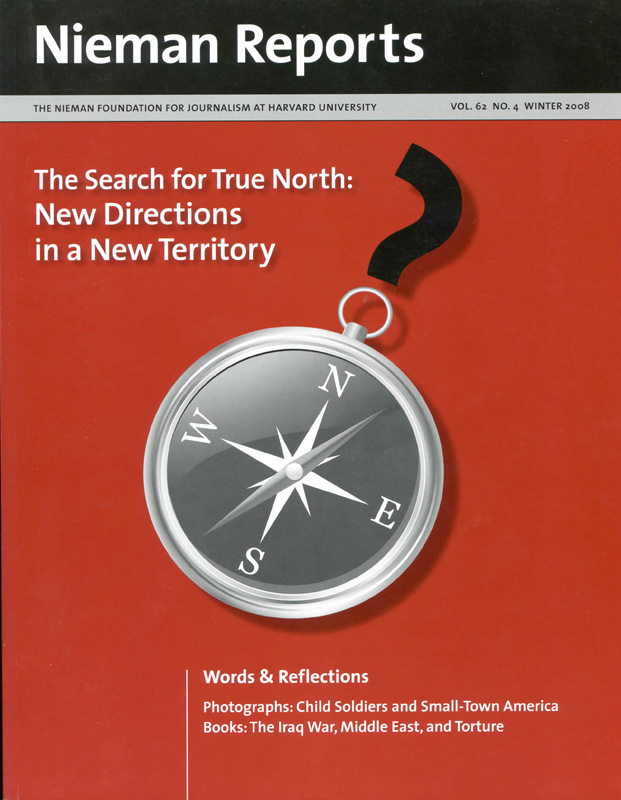Last night, just before I turned out the light to sleep, I grabbed my mobile from the night table. With a wireless Internet connection, I used the device to flip easily through headlines on the BBC and The New York Times. Nothing new there. I turned instead to my Twitter feed. Twitter is a microblog, a free Internet service for conversations and short-form publishing. Posts are limited to 140 characters. You can post from your mobile device or your desktop/laptop, updating whoever is reading your post real-time day and night, wherever you are. Who reads? People who choose to follow you. In turn, you choose to follow other people’s posts. You can reply publicly or privately to posts. It’s a short form, immediate and ongoing digital conversation.
About the time I was going to bed in London, Kirk LaPoint, managing editor of The Vancouver Sun, was attending a luncheon speech by former President Bill Clinton in British Columbia about the economy and the U.S. election, among other things. LaPoint was twittering (a new verb, like Google and blog have now become verbs) the speech. I’d started following his tweets since I met him briefly at the Online News Association conference in Washington in September. I only met him once, but by following his posts I learned more about what Clinton was thinking (or at least saying) from his nine 140-character posts than I have from any traditional news stories on the speech.
Twitter is fast becoming my preferred filter and guide to news and information as the people I choose to follow help me sift and sort the flood of data washing over me every day. They do this by finding, commenting on, and linking to news and information.
New Technology: Figuring Out What It Does
RELATED WEB LINK
Read Jay Rosen’s piece, “The People Formerly Known as the Audience,” which appeared on PressThink, his blog, in June 2006 »Why is this important? Because it is an example of how technology allows “the people formerly known as the audience,” as New York University journalism professor Jay Rosen calls them, to interact with and become part of the news process. And it is a glimpse at how this technology, which we used to just call blogs, is in the process of changing our world, and journalism, in ways we can’t begin to imagine.
It is the nature of disruptive technology that we almost always get it wrong when we try to guess the real use and impact of a new invention. In his book, “The Victorian Internet,” author Tom Standage describes how, after inventing the telegraph, its creators struggled for years before the world figured out how it might actually be used. In 1844, with a U.S. government-funded telegraph line functioning between Washington, D.C. and Baltimore, its inventor, Samuel F.B. Morse, was still trying to convince a skeptical world of his invention’s usefulness. “Yet after a while [Morse] realized that everybody still thought of the telegraph as a novelty, as nothing more than an amusing subject for a newspaper article, rather than the revolutionary new form of communication that he envisaged,” Standage writes.
Morse had originally tried to convince Congress to fund and use the telegraph for government communications, but the invention really took off when it started to be used for business and commercial communications. By the early 1850’s, sending and receiving telegrams had become “part of everyday life for many people around the world.”
Now, a century and a half later—and almost 15 years into the digital media revolution—there seem to be a few important things to note.
We don’t know what the impact will be of this flood of free, ubiquitous, easy-to-use new digital communication, content creation, and publishing tools that relate to journalism. “What tools?” we might ask. Well, the list changes so quickly that it will require updating in the time between when I write this article and when it is published. But here are a few examples:
- Blogging services, such as Google’s Blogger and Window’s Live Spaces and sharing, linking and tracking tools such as Technorati
- Microblogs, such as Twitter
- Video blogs, such as YouTube, Kyte.tv and 12seconds.tv, phreadz.com
- Mobile blogs, such as qik, moblog
- Social media sites including Facebook, Bebo, MySpace, LinkedIn, Plaxo, Flickr, Picasa
- Tagging and sharing sites such as del.icio.us, Digg, last.fm.
- Blog and Web site ads and promotion services, such as Google AdSense
There are, of course, many more being used by hundreds of millions of people around the world. And all of these tools I’ve mentioned allow anyone who can afford something as simple as a camera-enabled, Web-connected mobile device to create text, pictures, video and audio, post this content to a Web address, promote and potentially monetize it.
Journalism: ‘A Process, Not a Product’
Which brings me to my second point about blogging and journalism today.
The debate is over. Hand-inked bibles, horse-drawn carriages, pagers: A few still exist, but they have mostly been overtaken by newer technology. The same is true for the monopoly of the publisher. Journalists no longer control the message. Today digital publishing is practiced by the masses, and it’s inseparable from the practice of journalism. Newsgathering and distribution has changed forever, and the audience is part of the process.
Journalists, editors and media executives everywhere are struggling to come to terms with this fact and do what Gutenberg couldn’t have done with his printing machine—understand and predict where this innovation will take the economy, media, politics and society.
Journalists use blogs and journalists compete with blogs.
RELATED WEB LINK
Read Jeff Jarvis’s blog posting on this subject »Media blogger and journalism professor and blogger Jeff Jarvis (buzzmachine.com) writes and speaks frequently about a new role that journalists should embrace in a world in which The New York Times competes less with The Washington Post for readers’ attention than it does with blogs and social media. Jarvis, who teaches at the City University of New York, argues that journalism today is a “process not a product.” Journalists must sift, sort and curate the news, he contends. “Do what you do best. Link to the rest.”
The question Jarvis poses is this: Do we need more information or do we need, as a society, journalists dedicated to finding the gold nuggets amidst this raging river of content? The reality is that there are bloggers with passion and expertise on topics that exceeds anything that even the best reporter coming in on assignment could match.
RELATED ARTICLE
“The Wisdom of the Crowd Resides in How the Crowd Is Used”
– Jeff HoweThis is where traditional editors typically weigh in, saying “Yes, but bloggers aren’t trained journalists, they aren’t committed to fairness or objectivity the way journalists are.” In response, bloggers will point out that many readers don’t believe the mainstream media today are fair or objective, either. Instead, many leading bloggers argue that the Web forces transparency on any digital writer. If you fib, if you fake it, if you get it wrong, someone will notice and call you out. Analysts like Jarvis argue that this is peer review on a global scale. There’s even a name for it: “crowdsourcing.”
Crowdsourcing does not replace what traditional journalists do in interviewing, fact checking, verifying and making available important information to the public. But traditional journalists are no longer the only ones who can do this. Our work must incorporate and connect to the information being produced by specialists all around us.
An unpleasant and unproductive feature of the early years of mass digital publishing was that journalists and early bloggers spent a lot of time debating each other with red faces and pointed fingers about which side was more worthy, more reliable, more honest, and better served the readership and society. Thankfully, rhetoric has cooled as the digital media industry matures, and most mainstream journalists and editors embrace bloggers as part of the news process as well as blogging tools to engage in conversations with their readers, get tips and story ideas, and promote their own work. Many editors, including me, hesitate to consider a young journalist’s resumé unless they have a blog or some sort of social media site that will demonstrate their ability to report, write, use multimedia, interact appropriately with readers and, most importantly, think. Except for a few stragglers, most of my friends, colleagues and business contacts have some sort of Web site or blog, are on Facebook, Flickr, LinkedIn or Twitter.
So—brace for it—what this means is that we are all bloggers now. We are all participating in the media revolution.
I was asked recently to participate on a panel of London editors discussing the future of news. The question was posed: Are we living in the Golden Age of news or in its Dark Ages? It’s neither, of course, though all the online editors on the panel said Golden Age since it is certainly not the Dark Ages. To my mind, this revolution can be seen more as the next phase of the Enlightenment, which puts publishing and communication in the hands of the many, instead of the few who have traditionally controlled the media.
There is a human cost to any revolution. The printing press put out of work a lot of monks skilled in the art of lettering exquisite hand-made bibles. A unique skill was lost, or marginalized, but in exchange we gained nothing less than the flowering of knowledge and education of the masses, creating the fertile ground in which democracy has since flourished.
In the United States, the newspaper industry is being ravaged by cost-cuts and layoffs. A brain trust of experienced, highly trained reporters and editors are losing their jobs. Pulitzer Prizes and reader popularity do not protect these talented professionals from pink slips today. But even as newspapers are downsizing, dynamic new online publications arise. One of the more intriguing new digital publications is Tina Brown’s The Daily Beast. Gloriously named after Evelyn Waugh’s fictional British tabloid in “Scoop,” Brown’s “Beast” is an excellent example of journalism in the age of Web 2.0. It provides original interviews and reporting, staff blogs for context and analysis, and it focuses a lot of attention on filtering through important voices in the blogosphere and highlighting good blogs to help readers make sense of a vast array of data.
Is the U.S. newspaper industry going to die? No, but it clearly is undergoing massive, wrenching change. Former Nieman Foundation Curator Bill Kovach often says that each generation creates its own new culture of journalism. We are clearly in full creation mode right now. I can’t predict how that will play out, but I am enthusiastic and optimistic about the changes ahead for journalism and for the ability of citizens to get the information they need to participate in a democracy.
Katie King, a 1994 Nieman Fellow, is creative and development editor for MSN in the United Kingdom.



